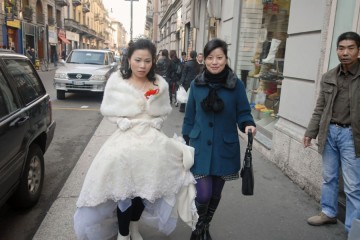A Milano le prime presenze di cinesi dello Zhejiang, prevalentemente provenienti dal distretto di Qingtian, risalgono agli anni venti, quando alcuni giovani uomini cinesi giunsero in città dalla Francia in cerca di nuovi sbocchi per le proprie attività di commercianti ambulanti. Negli anni successivi alla fondazione della Repubblica Popolare Cinese i flussi migratori dallo Zhejiang meridionale si affievolirono notevolmente: la Cina di Mao divenne virtualmente un paese chiuso, al punto che per molti cinesi parenti di emigranti divenne difficile anche solo mantenere contatti epistolari con i loro congiunti all’estero. Fu soltanto con l’avvio della nuova politica di “riforma e apertura” (gaige kaifang) inaugurata da Deng Xiaoping a partire dal 1979, che le catene migratorie ripresero vigore, inaugurando una nuova fase nelle migrazioni dalla Repubblica Popolare Cinese verso altri paesi.
Le prime attività, localizzate principalmente attorno a via Canonica furono legate alla lavorazione della seta, favorita dalla vicinanza con gli impianti industriali del comasco. Durante la seconda guerra mondiale la lavorazione venne convertita in quella della pelle, al fine di fornire cinture militari ai contingenti italiani e tedeschi. Il commercio all’ingrosso è sostanzialmente monotematico, prevalentemente concentrato sull’abbigliamento e la pelletteria. Dalla fine degli Anni ’90 c’è stato il boom delle agenzie immobiliari unito a quello dei telefonini e dell’hi-tech in genere. Data ai primi anni del 2000, invece, la comparsa di agenzie viaggi e internet point.
In Milan, the first appearances Chinese people from Zhejiang, mainly from the district of Qingtian, date back to the twenties, when some young Chinese men came to the city from France in search of new outlets for their activities of itinerant traders. In the years following the founding of the PRC migration from southern Zhejiang dimmed considerably: Mao’s China became virtually a closed country, to the point that for many Chinese relatives of emigrants became difficult even to maintain contact by letter with their relatives to ‘foreign. It was only with the launch of the new policy of “reform and opening” (gaige Kaifang) inaugurated by Deng Xiaoping in 1979, that the migratory chains prevailed, ushering in a new phase in the migration from the Republic of China to other countries. The first activities, located mainly around via Canonica were linked to the production of silk, favored by the proximity to industrial installations in Como. During World War II processing was converted to that of the skin, in order to provide belts to Italian and German armies. Wholesale is essentially monothematic, mainly focused on clothing and leather goods. Since the late ’90s there was a boom in real estate combined with that of mobile phones and hi-tech in general. Date to the early 2000s, however, the appearance of travel agencies and internet point.

